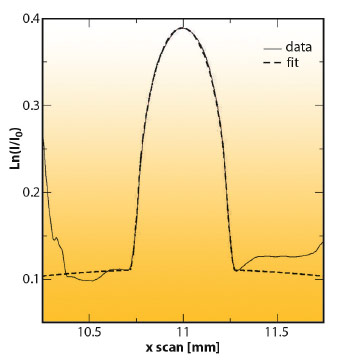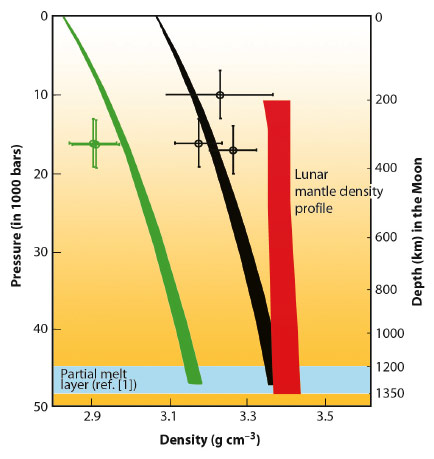- Home
- Users & Science
- Scientific Documentation
- ESRF Highlights
- ESRF Highlights 2012
- Dynamics and extreme conditions
- Dense molten rocks in the interior of the Moon
Dense molten rocks in the interior of the Moon
A 2011 NASA study [1] of moonquakes, based on seismometer measurements made during the Apollo missions, revealed a surprising new view of the lunar interior: the deepest parts of the rocky mantle of the Moon, at depths between 1200 and ~1350 km, appear to contain large amounts of molten rock (magma). In fact, up to 30 per cent of this deep layer may be molten. On Earth, such melt percentages would be accompanied by the formation of volcanoes, because magma formed in the interior of the Earth is less dense than the rock it originates from. This density difference provides a driving force for upward transport, leading to volcanic eruptions at the surface. However, despite the presence of large amounts of magma in its interior, the Moon has no active volcanoes. We have found an explanation for this apparent discrepancy by subjecting synthetic Moon rocks to extreme pressures and temperatures and measuring the density of the resulting magma using in situ techniques at beamline ID27.
Volcanic rocks on the Moon, sampled by Apollo astronauts, show a range in chemical composition that is much wider than that found on Earth. In particular, they show a very large range in titanium content, from less than 1 weight percent (wt%) in TiO2 to approximately 16 wt%. We measured the effect of this compositional variation on magma densities at lunar interior pressure and temperature conditions.
Magma densities were determined in situ by combining Paris-Edinburgh high-pressure equipment with synchrotron X-ray absorption techniques [2]. Finely-powdered synthetic lunar rocks, inserted into natural diamond cylinders, were subjected to lunar interior pressures and heated to extreme temperatures inducing sample melting. Molten sample densities were obtained by measuring the absorption of synchrotron X-rays by the sample (Figure 37). In situ measurements were combined with computer simulations [3] to constrain lunar melt densities.
 |
|
Fig. 37: X-ray absorption as a function of X-ray beam position in the x-direction (in mm) for molten low-titanium lunar glass at P = 16000 bar, T = 1908 ± 50 K (solid line); Units ln(I/I0) with I the intensity of the X-ray beam after passing through the sample assembly, and I0 the intensity before passing through the assembly. The dotted curve shows the best fit to the data, giving a magma density 2.87 ± 0.03 g cm-3. The enhanced absorption at low x values shows the position of platinum-bearing pressure-temperature calibrants touching the outside of the diamond sample capsule. |
Results, summarised in Figure 38, show that virtually all magma in the Moon is less dense than the rocks they originate from, as is the situation on Earth. There is one exception: the most Ti-rich magmas become neutrally buoyant (as dense as their surroundings) at the deepest levels in the lunar mantle – exactly where the NASA study [1] detected magma.
 |
|
Fig. 38: Compilation of our in situ data (circles) and densities obtained from computer simulations (coloured curves). Green: lunar magma with < 1 wt% TiO2. Black: lunar magma with 16 per cent by weight TiO2. The blue bar indicates the area of partial melt according to ref. [1]. The red area represents estimates of the present-day density profile in the lunar mantle. |
Such titanium-rich melts are formed by partial melting of titanium-rich solid rocks. Lunar sample analysis previously showed such rocks originally formed at shallow depths (<100 km) during the early evolution of the Moon. Our results therefore suggest that significant vertical rock transport occurred before magma generation, providing new constraints on lunar interior evolution.
Principal publication and authors
M. van Kan Parker (a), C. Sanloup (b,c), N. Sator (d), B. Guillot (d), E.J. Tronche (a), J-P. Perrillat (e), M. Mezouar (f), N. Rai (a) and W. van Westrenen (a), Nature Geoscience 5, 186-189 (2012).
(a) Faculty of Earth and Life Sciences, VU University Amsterdam (the Netherlands)
(b) UPMC Université Paris 06 and CNRS, UMR 7193, Paris (France)
(c) SUPA, School of Physics and Astronomy, and Centre for Science at Extreme Conditions, The University of Edinburgh (UK)
(d) Laboratoire de Physique Théorique de la Matière Condensée (UMR7600), Université Pierre et Marie Curie (Paris 6) (France)
(e) Laboratoire de Sciences de la Terre, Université Claude Bernard Lyon 1, UMR5570 CNRS ENS Lyon (France) (f) ESRF
References
[1] R.C. Weber, P.Y. Lin, E.J. Garnero, Q. Williams and P. Lognonne, Science 331, 309-312 (2011).
[2] M. van Kan Parker, C. Sanloup, E.J. Tronche, J-P. Perrillat, M. Mezouar, N. Rai and W. van Westrenen, High Pres. Res. 30, 332-341 (2010).
[3] B. Guillot and N. Sator, Geochim. Cosmochim. Acta 71, 4538-4556 (2007).



